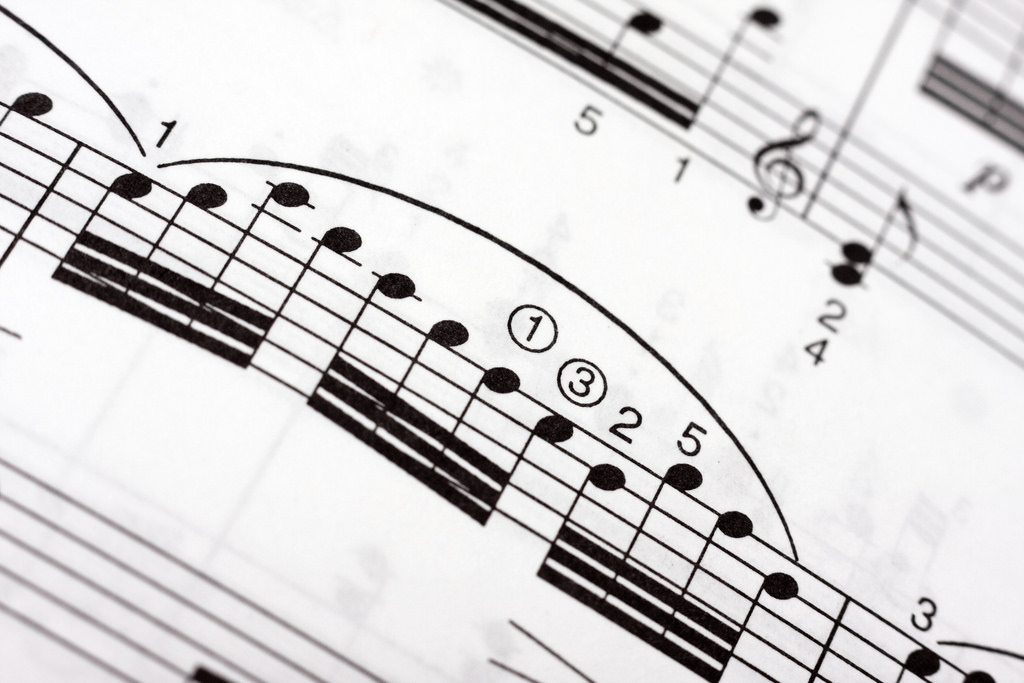
Dominant and diminished seventh chords are common and important features of music. It’s hard to find a piece of music that doesn’t use either of these. In fact, they’re so prevalent that the higher grades of the ABRSM examinations require students to know them by heart.
Unfortunately, they’re also rather dissonant and odd sounding. I remember asking my piano teacher what was the point of learning such harsh sounding chords. Nevertheless, when used appropriately, they sound perfectly beautiful and logical in the context of the whole piece. We’ve probably already heard and played these chords in many pieces of music, without noticing the dissonance produced by these chords. In this article, we’ll explore the construction and uses of dominant and diminished seventh chords.
What are seventh chords?
But before we begin, let’s take a quick look at what a “seventh chord” is.
There are varying definitions of “chord,” but it typically refers to a harmonic group of notes (at least two, but usually three or more) sounded together. A seventh is formed by two notes that have an interval of seven letter names between them (eg. A and G).
Put together, a “seventh chord” is chord composed of a triad and a note forming the interval of a seventh above the chord’s root (the lowest note). Here is an example:

Note that matter how the notes are sharpened or flattened, the chord shown above is still a seventh chord, although the type of seventh chord changes.
There are five main types of seventh chords, namely: major, minor, dominant, diminished, and half-diminished seventh chords. In this article, we focus on dominant and diminished seventh chords.
While the different types of seventh chords have their own uses, seventh chords have generally been used to create tension through dissonance, allowing the songwriter to emphasize movement through the need to resolve this tension. While seventh chords were mainly used as embellishments in the past, dissonance has become more mainstream in the 20th and 21st centuries, and seventh chords are also mainstays of certain genres such as jazz and metal, where dissonance is used to create funky and harsh sounds respectively.
Dominant Seventh Chords
What are dominant seventh chords?
In music, a dominant refers to the fifth note of any scale (ie. “sol” in “do-re-mi-fa-sol). A dominant seventh chord consists of the dominant triad (fifth note of the scale is the root of the dominant chord) and an added note a minor seventh above the root.
For example, the dominant seventh chord in C major (or minor) is G-B-D-F.
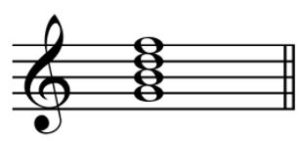
When using roman numerals to denote chords, dominant seventh chords are notated with “V7”. In piano/guitar chords, you’ll see a “7” written beside the letter of the chord root. For example, the chord above is a G7.
Formation of dominant seventh chords
With respect to the root, all dominant seventh chords consist of a major third (dominant-leading note), a perfect fifth (dominant-supertonic) and minor seventh (dominant-subdominant). This means that all dominant seventh chords are major chords, regardless of the key.
Here is a table of dominant seventh chords in some keys.
Key | Root | Major 3rd | Perfect 5th | Minor 7th |
| C | G | B | D | F |
| D | A | C♯ | E | G |
| E | B | D♯ | F♯ | A |
| F | C | E | G | B♭ |
| G | D | F♯ | A | C |
| A | E | G♯ | B | D |
| B | F♯ | A♯ | C♯ | E |
Notice that the leading note and subdominant form a diminished fifth (tritone). The clashing sounds produced by playing these two notes together gives the dominant seventh chord its dissonant quality.
Function of dominant seventh chords
Most importantly, the dominant seventh chord resolves to the tonic chord. Tonic chords consist of the tonic, mediant (third note of the scale) and dominant notes. The dominant seventh chords contain notes that would likely be succeeded by notes of the tonic chord.
With reference to a piece in C major such as in the diagram below, dominant seventh chords contain the leading note of the scale (B), which has a strong tendency to progress to the tonic (C). The inclusion of the subdominant (F) makes the transition to the mediant (E) more natural as well.
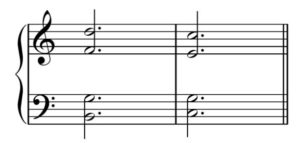
An example of a V7-I progression in C major.
While an ordinary dominant chord would work just fine for resolution to the tonic chord, the addition of the seventh gives the chord not only a greater degree of richness, but also additional dissonance that demands urgent resolution to the tonic.
This additional dissonance is also useful for modulations. To establish a change in key, songwriter usually place a tonic chord on a strong beat. A dominant seventh of the new key gives a strong “push” towards the new tonic.
Aside from resolutions to the tonic, dominant sevenths are useful for harmonizing tones of the major scale. Dominant seventh chords, combined with the tonic chord, can harmonize every tone of the major scale, except for the submediant (sixth note).
Diminished Seventh Chords
What are diminished seventh chords?
A diminished seventh chord is a diminished triad, with an added note of a diminished seventh interval from the root. A diminished seventh chord contrasts from the half-diminished seventh chord in its seventh note; the half-diminished seventh is a diminished triad with a note added that is a minor seventh from the root.
While dominant seventh chords are defined with reference to a scale, it would make no sense to do so with diminished seventh chords. The notes that comprise a diminished seventh chord, cannot be part of any one major or minor scale. Diminished seventh chords are typically defined by their root note. Here is an example of a diminished seventh chord on C.
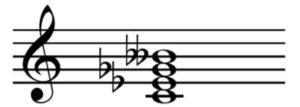
In pop guitar/piano chords, diminished seventh chords are usually written with a “dim7” or “°7” beside the tonic note. The diminished seventh chord illustrated above will be written as “Cdim7 or C°7.
Formation of diminished seventh chords
With respect to the root, all diminished seventh chords consist of a minor third, diminished fifth and diminished seventh. This means that all notes are a minor third apart (eg. C-E♭, E♭-G♭, G♭-B♭♭).
Here is a table of some diminished seventh chords with different roots.
Root | Minor third | Diminished fifth | Diminished seventh |
| C | E♭ | G♭ | B♭♭ |
| D | F | A♭ | C♭ |
| E | G | B♭ | D♭ |
| F | A♭ | C♭ | E♭♭ |
| G | B♭ | D♭ | F♭ |
| A | C | E♭ | G♭ |
| B | D | F | A♭ |
Notice that there are two tritones in the diminished seventh chord, formed by the root and diminished fifth notes as well as the minor third and diminished seventh notes. This makes the diminished seventh chord sound extremely dissonant, even more so than the dominant seventh chord.
Function of diminished seventh chords
Diminished seventh chords can serve a similar purpose as dominant seventh chords, with their highly dissonant property. They are useful for resolution to the tonic. In fact, if you remove the dominant note from a dominant seventh chord, you will get a diminished triad, to which a diminished seventh can be added to form a diminished seventh chord. The resulting diminished triad will be rooted in the leading note of the scale, which tends to progress to the tonic. The other notes (subtonic, subdominant, and submediant) can resolve to the mediant and dominant notes in the tonic chord. Here’s an example in C minor.
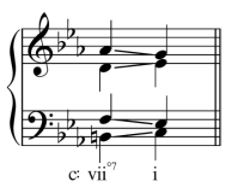
Since diminished seventh chords do not belong to any specific key, they possess an ambiguous quality. This makes the chord an effective transition to any atypical chords and new keys, even very distant keys. By dropping the pitch of any one note in a diminished seventh chord by a semitone, the chord becomes the dominant seventh chord of a new key, which then can be resolved to the tonic to establish a change in key.
Root | Minor third | Diminished fifth | Diminished seventh |
C | E♭ | G♭ | B♭♭ |
Let’s take a look at the diminished seventh chord starting with C. By dropping C to B, a dominant seventh chord in E is formed (B-D♯-F♯-A). By dropping E♭ to D, we get a dominant seventh chord in G (D-F♯-A-C). By dropping G♭ to F or B♭♭ to A♭, we get dominant seventh chords in B♭ and D♭ respectively.
In order to modulate to E major or minor, we can first play a diminished seventh chord in C. Keeping the other three notes at the same pitch, and dropping C to B, we then play the dominant seventh of E. After that, we can resolve to the tonic chord of E major or minor to firmly establish the new key. This process is also known as common tone modulation by diminished seventh chords.
Common tone modulation is really useful because dominant seventh chords always include a major triad regardless of the key and diminished seventh chords can be used to modulate to any major or minor key. Moreover, since diminished seventh chords don’t belong to any key, you can use any diminished seventh chord to modulate to any key, no matter how distant they are!
Lastly, the dissonant sound of a diminished seventh chord lends it a haunted, tormented quality. The chord is often used to evoke feelings of anger, fear or tension. However, some say that this has become so contrived that it’s no longer advisable to use it for this purpose.
Coda
Dominant and diminished seventh chords are versatile chords that are commonplace in most, if not all types of music. Be sure to add them to your repertoire if you’re a budding composer or songwriter!
To find out more about other interesting features of music, why not start learning with Liberty Park Music? Start your free trial today!
About Liberty Park Music
LPM is an online music school. We teach a variety of instruments and styles, including classical and jazz guitar, piano, drums, and music theory. We offer high-quality music lessons designed by accredited teachers from around the world. Our growing database of over 350 lessons come with many features—self-assessments, live chats, quizzes etc. Learn music with LPM, anytime, anywhere!











Thank a lot this information cleared a lot of my confusio ,particularly since the net is my only source of knowledge for music theory
“For example, the dominant seventh chord in C major (or minor) is G-B-D-F.”
Really? Not C E G B?
Consider removing this article til corrected. You may be confusing many.
Hi there, thanks for your comments. Yes, the domninant seventh chord in (the key of) C major or C minor is G-B-D-F. A dominant (seventh) chord is a chord built of the scale degree 5 of the key. So in this case, scale degree 5 in the key of C is G. Hence G-B-D-F. If you want to notate this chord with a chord symbol (which is commonly found in lead sheets), it would be G7.
So the statement you quoted is correct. But we appreciate that we could have made it even clearer to avoid confusion.
The chord you are thinking is probably C7 (C-E-G-Bb). That would be the dominant seventh chord in the key of F.
So if we look at C7 (C-E-G-Bb), it’s the dominant seventh chord of the key of F major or minor. C is the scale degree 5 of (the key of) F.
Thanks form the information on Dominant and Diminished Seventh Chords.It helped me clarify some questions on this subject